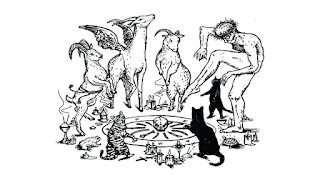Hopefully, it can now be (at least partially) understood why this widely disseminated and much-elaborated narrative about a reputedly malevolent object displayed in a world-famous museum, has mutated into a ghost story attached to the nearby abandoned underground station. However, while the majority of accounts agree that the ghost is that of an ancient Egyptian, on studying published and online accounts it becomes difficult to determine the exact identity, or gender, of this spirit. The variety of candidates I have discovered so far are listed below, as they have been described:
- an ancient Egyptian in 'traditional' headdress and loincloth
- the Egyptian god Amun/Amen-Ra
- the mummy of Amun/Amen-Ra (presuming a god can be mummified?)
- the priestess of the cult of Amun/Amen-Ra said to be depicted on the mummy-board in the British Museum
- the mummy of the priestess of the cult of Amun/Amen-Ra at the BM
- the priestess Amen-Ra
- the Princess of Amen-Ra, the Princess Amen-Ra (from the same page of a book on ghosts on the underground)
- an Egyptian looking for a mummy
A further facet of the underground ghost story is the secret tunnel that supposedly connects the British Museum with the abandoned station of the same name and is traversed by the ghost. The most likely source for this added element is a British film released in 1935 (two years after the station closed) called Bulldog Jack (Dir. Walter Forde, released as Alias Bulldog Drummond in the USA). Older readers will probably remember Captain Hugh "Bulldog' Drummond, often described as a 'gentleman adventurer' perpetually getting into scrapes with foreign spies and damsels in distress, whose roots lay in such popular fictional figures as Sexton Blake and Richard Hannay. In this film Drummond is injured in a sabotaged car and has to be impersonated by the hapless Jack Pennington (Jack Hulbert), who becomes involved in a plot to replace a valuable necklace in the British Museum with a forgery.
A gang led by a villain called Morelle (Ralph Richardson) kidnap the jeweller grandfather of Ann Manders (Fay Wray), who they need to manufacture the worthless copy. Significantly the thieves' hideout is an abandoned underground station named 'Bloomsbury', obviously based on British Museum. To get into the museum at night they make use of a secret tunnel from the station, emerging through a tomb-chest, the lid of which rises up on jacks. This film is mentioned in some of the literature on abandoned stations, but one book mistakenly states that the museum entrance to the tunnel in the film is through the lid of an Egyptian sarcophagus, which swings open, thus evoking once more the Egyptian mummy theme.
To add to the mysterious underground shenanigans, online sources now note: 'It is often said that on the night that this movie opened, two women went missing from Holborn station and never-described marks [?] were found in the British Museum station during the investigation.' I have so far been unable to find any national newspaper article from the mid-1930s referring to 'missing' women at Holborn station or, it has to be added, any mention from the early 1930s papers of the ghost of an 'ancient Egyptian' at British Museum station. There were, however, a number of articles in the national press about the 'Unlucky Mummy' in the museum. I have yet to go through the local newspapers for Camden and Holborn, (which have not been digitised) for this period and these may yield more information.
Another film should also be mentioned with reference to this piece of folklore: Death Line (dir. Gary Sherman, premiered in London in December 1972 -later released in the USA in October 1973 as Raw Meat - to be issued on Blu-ray in August this year) concerned the grisly antics of a cannibal living in abandoned tube tunnels, the last descendent of a group of Victorian railway workers who survived a cave-in when they were tunnelling the tube. He subsists by snatching passengers and railway workers late at night, taking them back to his subterranean lair and devouring them. The only words he can utter are 'Mind the doors'. Much of the underground action takes place in Russell Square and Holborn stations. The plot has possibly influenced an urban legend, reported in Issue 105 of Fortean Times (December 1997) of a race of subterraneans living on a diet of discarded takeaways and careless vagrants.
Plots involving monsters or mutants living in the London underground and preying on commuters also feature in a number of films, including An American Werewolf in London (dir. John Landis, 1981) and Creep (dir.Christopher Smith, 2005). From their spaceship, unearthed during a tube extension at Hobb's Lane underground station, Martians although long dead, are still capable of wreaking havoc in Quatermass and the Pit (dir. Roy Ward Baker, 1967) and in the Patrick Troughton-era Doctor Who episodes The Web of Fear (thought lost, but now mostly recovered and issued on dvd) robot yeti stalk the tube tunnels of central London.
In recent years attention has focussed on Holborn station, presumably as very few people have heard of the abandoned and inaccessible stop nearby. To quote the Daily Mail online once more: 'It has long been rumoured that there is a secret tunnel stretching from Holborn station to the British Museum's famous 'Egyptian Room' - perhaps Amun-Ra has been letting himself loose on the Underground during the small hours.'
Holborn is one of the busiest stations on the tube network, with 63 million passengers using it every year. According to Transport for London: 'The station is too small for current demand, creating crowding and queuing.' Plans are currently underway to substantially increase capacity at Holborn (including a second entrance, eight new escalators and an additional 700 metres of tunnel). Work is intended to begin in 2021, if permission is granted, and also, one imagines if the peripatetic spirit of Amun-Ra will allow it to proceed.


















